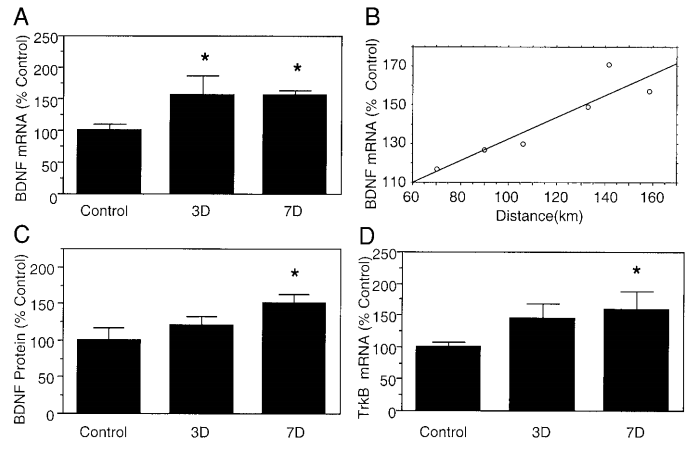BDNF growth factor - Info
BDNF GROWTH FACTOR

Figure Nr.1 : From top to bottom, Pro-BDNF, Schematic representation of an ELISA-Kit for the detection of Pro BDNF. Source : Aviscerabioscience.
BDNF (brain-derived neurotrophic factor) belongs to the group of neurotrophins and influences nerve growth in the central and peripheral nervous systems. BDNF as well as its receptor TrkB are expressed in mammals during development as well as in adult age (Figure No. 1). The interaction of BDNF and TrkB stimulating substances activates intracellular processes that are crucial for neuronal survival, morphogenesis and neuronal plasticity. The binding of BDNF to TrkB activates intracellular signaling pathways. These include among others the MAP kinase pathway (MAPK / ERK), the PI3K pathway and other similar biological pathways. Overall, BDNF is significantly involved in the positive or negative influence of neurons, which ultimately determines their survival and neuronal plasticity. In addition to TrkB, p75 is also a low affinity receptor for BDNF. BDNF has been implicated several times in the pathophysiology of various brain disorders. These include diseases like depression, schizophrenia, anorexia nervosa as well as bulimia nervosa. It can be assumed that the stress-induced glucocortiocoid interacts with BDNF in the development of these diseases. There may be a possible crossover between glucocorticoid and BDNF / TrkB medi-ated signal transduction. BDNF and its effects on the human organism are therefore important features of current research. Its role in mental illnesses such as depression is of particular interest. According to WHO, around 322 million people worldwide were affected by the disease in 2015, representing 4.4 percent of the world's population. The number of affected people is rising rapidly and has risen by about 18 per-cent since 2015.

Recent findings show that especially disstress and concomitant negative side effects lead to a re-duction of the BDNF concentration in the brain, which is a favor for the development of mental and neurodegenerative diseases. However, it is possible to increase BDNF levels through exercise, thereby increasing hippocampal plasticity, which can provide an antidepressant effect (Figure No. 2). The increase of the BDNF values, by physical activity also intensifies the effect of antidepres-sants.
PRODUCTS
ELISA-KITS
WESTERN BLOT
PROTEINS
ANTIBODIES
References
Arancio O, Chao MV: Neurotrophins, synaptic plasticity and dementia. In: Curr. Opin. Neurobiol.. 17, Nr. 3, Juni2007, S. 325–30. doi:10.1016/j.conb.2007.03.013. PMID 17419049. Mercader JM, Fernández-Aranda F,Gratacòs M, Ribasés M, Badía A, Villarejo C, Solano R, González JR,Vallejo J, Estivill X: Blood lev-els of brain-derived neurotrophic factor correlate with several psychopathological symptoms in anorexia nervosa patients. In:Neuropsychobiology. 56, Nr. 4, 2007, S. 185–90. doi:10.1159/000120623. PMID 18337636.
Dwivedi Y,Brain-derived neurotrophic factor: role in depression and suicide. In: Neuropsychiatr Dis Treat. 5, 2009, S. 433–49. PMID 19721723. PMC 2732010 (freier Volltext).
Numakawa, T.,Suzuki, S., Kumamaru, E., Adachi, N., Richards, M., & Kunugi, H. (2010). BDNF function and intracellular signaling in neurons. Histology and histopathology, 25(2), 237-258.
Schuch, F. B., Rocha, N., & Cadore, E. L. (Eds.). (2015). Progress in Physical activity and Exercise and Affective and Anxiety Disorders: Translational Studies, Perspectives and Future Directions. Frontiers Media SA.
Xiu MH,Hui L, Dang YF, De Hou T, Zhang CX, Zheng YL, Chen DC, Kosten TR, Zhang XY: Decreased serum BDNF levels in chronic institutionalized schizophrenia on long-term treatment with typical and atypical antipsy-chotics. In: Prog. Neuropsychopharmacol. Biol. Psychiatry. 33, Nr. 8, August 2009, S. 1508–1512. doi:10.1016/j.pnpbp.2009.08.011. PMID 19720106.
https://www.aerzteblatt.de/nachrichten/73297/WHO-Millionen-leiden-an-Depressionen



